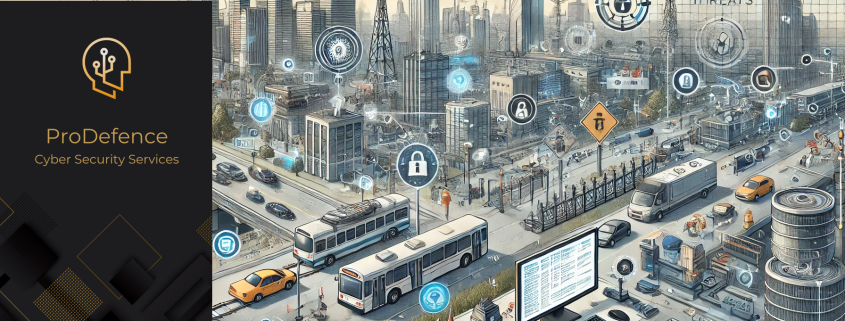NIS 2 – Transport – Implementing cyber security measures in essential services: A critical need
Introduction
The growing dependence on digital infrastructure in various sectors has exponentially increased the risk of cyber threats. These threats can lead to catastrophic consequences if not properly managed, especially in essential services. Cyber-attacks can disrupt critical operations, compromise sensitive data and cause financial and reputational damage. The NIS 2 Directive seeks to address these risks by mandating robust cybersecurity measures in critical sectors.
Essential services such as energy, transport, banking and healthcare are the backbone of modern society. Disruption can have far-reaching consequences, affecting not only the immediate sector, but also the economy and public safety. As cyber threats become more sophisticated, it is crucial to implement comprehensive cyber security strategies to protect these services from potential attacks.
This paper aims to highlight the importance of implementing these measures by examining potential threats and their impact on essential services. By understanding the risks and the necessary cybersecurity measures, we can better protect critical infrastructure and ensure the continuity of essential services.
Overview of the NIS 2 Directive
The Networks and Information Systems (NIS) 2 Directive is a key piece of EU legislation designed to improve the cyber security of critical infrastructure. It extends the scope of the original NIS Directive, increasing the obligations for Member States and operators of essential services to enhance their cybersecurity capabilities.
Key objectives of the NIS 2 Directive
- Strengthening cyber security: Improving the security of networks and information systems across the EU.
- Increased cooperation: Improved cooperation between Member States and the European Union Cyber Security Agency (ENISA).
- Harmonization of regulations: Ensure consistent cybersecurity requirements across Member States.
- Improve incident reporting: Establish mandatory reporting of significant cyber incidents to relevant authorities.
Key provisions
- Broad scope: Includes additional sectors such as health, digital infrastructure and space.
- Risk management: requires operators to adopt risk management practices, including technical and organizational measures.
- Incident Response: Mandates the development and implementation of incident response plans.
- Supply chain security: emphasizes the need to address cyber security risks in the supply chain.
Key services and potential cyber threats
- Energy
- Transportation
- Banks
- Financial market infrastructures
- Health sector
- Drinking water supply and distribution
- Digital infrastructure
- Public administration
- Spazio
Transportation
Description:
The transportation sector involves moving people and goods by air, rail, road and sea. It includes systems such as air traffic control, rail signaling and maritime navigation.
Potential Cyber Threats:
- Air Traffic Control Disruption:
- Description.
- Impact: It affects passenger safety, causes economic losses for airlines and can lead to chaos at airports.
- Examples: Distributed Denial of Service (DDoS) attacks on air traffic control systems, such as the FAA incident in the US in 2015.
- Failures of Rail Signaling Systems:
- Description: Hacking signaling systems can cause train collisions and derailments, resulting in significant loss of life and property.
- Impact: Major risk to passenger and staff safety, economic losses and disruption to rail transport.
- Examples: attacks on railway signaling systems, such as the cyber attack on Polish railways in 2022.
- Compromising Maritime Navigation Systems:
- Description: Compromised navigation systems can lead to ship collisions or groundings, disrupting global supply chains.
- Impact: Affects international trade, can cause oil spills and other environmental incidents, and endangers the lives of crews.
- Examples: cyber attacks on ships’ GPS systems, such as incidents reported in the Strait of Hormuz.
- Hacking Public Transportation Systems:
- Description: Attacks on public transportation systems can disrupt services and pose risks to passenger safety.
- Impact: It causes delays and cancellations, affects the daily mobility of thousands of people and can create panic among the public.
- Examples: ransomware attacks on ticketing or subway train control systems, such as the San Francisco Muni incident in 2016.
Mitigation Strategies:
- Monitoring and Response Systems: deployment of advanced monitoring systems for real-time threat detection and response.
- Security Audits and Penetration Tests: Conduct regular security audits and penetration tests to identify and remediate vulnerabilities.
- Incident Response Planning: Develop and regularly update incident response plans to ensure rapid and effective responses to cyber incidents.
- Collaboration and Information Sharing: Promote collaboration between carriers and government agencies to share threat intelligence and best practices.
- Critical Infrastructure Protection: Strengthening critical infrastructure protection measures such as access control and encryption of communications.
By understanding these potential threats and implementing robust mitigation strategies, the transportation sector can increase resilience against cyber-attacks and ensure the continued provision of essential services.




